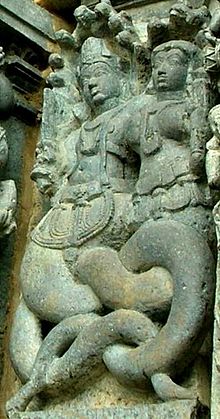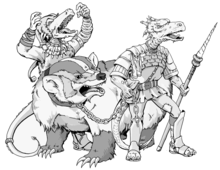Reptilian humanoid
This article's lead section may be too short to adequately summarize the key points. (December 2021) |

Reptilian humanoids, or anthropomorphic reptiles, are fictional creatures that appear in folklore, fiction, and conspiracy theories.
In folklore

In South Asian and Southeast Asian mythology, the Nāga are semi-divine creatures which are half-human and half-snakes.[1]
Claims of sightings of reptilian creatures occur in Southern United States, where swamps are common. In the late 1980s, there were hundreds of supposed sightings of a "Lizard Man" in Bishopville, South Carolina.[2]
In fiction
Anthropomorphic reptilian races or beings commonly appear in fantasy and science fiction. They can be based on various reptiles, like lizards, crocodiles, alligators, snakes, dinosaurs, and the fictional dragons. They are often depicted as powerful warriors, though their relative intelligence to humans varies – as with other anthropomorphic races, a greater resemblance to humans often denotes more "civilized" behavior. Some anthropomorphic reptilians such as lizards and snakes are often associated with jungles, swamps, and other tropical biomes, and as such are seen with cultural elements of similar regions, including Mesoamerican cultures.
Fantasy
The Serpent Men, reptilian humanoids who can project illusions of human form, appeared as villains throughout Robert E. Howard's King Kull stories starting in 1929 as well as in the linked Cthulhu Mythos. Edgar Rice Burroughs' Pellucidar series featured primitive dinosaur-descended humanoids living in the Hollow Earth called the Horibs or snake-men in his 1929–1930 crossover Tarzan at the Earth's Core. These almost simultaneous inventions originated the modern reptilian humanoid trope.[3][4][5][6] In the 1980s, the animated television series Dino-Riders feature a race called the Rulons, of which some individuals were reptilian humanoids, that served as the main antagonist to the protagonist Valorians upon which the series is based. Merchandise based on the series included several series of toys, among which they included replicas of the reptilian Rulons.[7]
Video games

Examples of reptilian races in fantasy games are the Lizardmen from Warhammer as well as Lizardfolk, Dragonborn and Kobolds of the Dungeons & Dragons tabletop role-playing game.
The Dragonborn in particular – based on the Draconians of Dragonlance, which in that game were uniformly evil – were originally introduced in the Dungeons & Dragons 3.5 supplement book Races of the Dragon, published by Wizards of the Coast in 2006.[8][9] In 4th Edition, dragonborn are available as one of the core player character races in the Player's Handbook.[10][11]
The dragonborn were introduced to the core rules in an attempt to reflect contemporary trends in fantasy fiction and appeal to newer players.[12][13] In addition, it reflected a perception among the game's designers that it should be possible to play dragon-like creatures in a game with "Dragons" in the title.[12][14] Richard Baker, who helped design 4th Edition, noted that the introduction of dragonborn to the core rules allowed them to "grow the D&D world by allowing the mix of characters to evolve in the new edition."[14] Jonathan Bolding of The Escapist noted that the inclusion of the dragonborn in the 5th edition Player's Handbook does "push the 'traditional D&D' mold a bit, but this is a greatest hits of D&D player races and powers from the last fifteen years of the game."[15]
Anthropomorphic reptilians are also shown in video games, especially in fantasy games. The lizardlike Argonian race takes a prominent role in the fantasy video game franchise The Elder Scrolls. Other examples of reptilian humanoids in fantasy games include the Man-Serpents from the game Elden Ring and the Naga from World of Warcraft.
Science fiction
In works of science fiction, aliens are often depicted as closely resembling animals, with reptilian aliens being no exception. An early appearance was in the story "The Lizard-Men of Buh-Lo" (1930) by Francis Flagg.[16] Other examples include the Gorn from Star Trek and the Dracs from the film Enemy Mine (1985).[16]
The television franchise V features the Visitors, a lizardlike alien race who disguise themselves as humans.[16]
The Cardassian race featured in multiple Star Trek series, is another example of reptilian humanoids in that particular science fiction universe.[17] The "Tosk" people, featured on Star Trek: Deep Space Nine, is another.[18] The "Distant Origin" episode of Star Trek: Voyager then features the Voth, a race descended from the dinosaurs that had escaped extinction by leaving Earth and relocating to the Delta Quadrant.[19]
On the television series Doctor Who, there are also races of reptilian humanoids, such as the Silurians[20] and Ice Warriors.
Conspiracy theory
The reptilian conspiracy theory alleges that shape-shifting reptilian aliens control Earth.[21]
Belief in reptilians sometimes references anti-Semitic texts. For example, the perpetrator of the 2020 Nashville bombing was influenced by the writings of David Icke, who in turn referenced 1903 anti-Semitic fabricated text The Protocols of the Elders of Zion.[22][23][24][25]
See also
References
- ^ "Naga | Hindu mythology". Encyclopedia Britannica. Retrieved 2019-09-11.
- ^ Milligan, Stephen (1988-08-07) "Sightings of a monster lizard from the swamp has struck terror into a small community in South Carolina", The Sunday Times.
- ^ Trompf, Garry W.; Bernauer, Lauren (2012). "Producing Lost Civilisations: Theosophical Concepts in Literature, Visual Media and Popular Culture". In Cusack, Carole; Norman, Alex (eds.). Handbook of New Religions and Cultural Production. Leiden: Brill. pp. 113–114. ISBN 978-9004221871. Archived from the original on 30 March 2019. Retrieved 3 September 2014.
- ^ Debus, Allen A. (7 June 2016). Dinosaurs ever evolving : the changing face of prehistoric animals in popular culture. ISBN 9780786499519.
- ^ "Top Ten Favorite Edgar Rice Burroughs Monsters". Dark Worlds Quarterly. 3 October 2020.
- ^ Barkun, Michael (2003). A Culture of Conspiracy: Apocalyptic Visions in Contemporary America. Berkeley and Los Angeles: University of California Press. p. 121. ISBN 0520238052. Archived from the original on 23 August 2019. Retrieved 3 September 2014.
the shadow kingdom.
- ^ "Activate the Nostalgia Center: Remembering DinoRiders". Wired magazine. January 29, 2009.
- ^ "Races of the Dragon Excerpt". Archived from the original on February 7, 2006.
- ^ Kestrel, Gwendolyn F.M.; Wilkes, Jennifer Clarke; Liquette, Kolja Raven (2006). Races of the Dragon. Wizards of the Coast.
- ^ "20 Things About Dungeons & Dragons That Make No Sense". ScreenRant. June 2, 2018.
- ^ Heinsoo, Rob; Collins, Andy; Wyatt, James (2008). Player's Handbook. Wizards of the Coast.
- ^ a b Tresca, Michael J. (2010). The Evolution of Fantasy Role-Playing Games. McFarland. p. 81.
- ^ "D&D Player's Handbook: Then and Now". Wired. wired.com. 2008-07-30. Retrieved 2015-07-16.
- ^ a b "Player's Handbook Races: Dragonborn (4e)". rpgnow.com. 2015-03-31. Retrieved 2015-07-21.
- ^ "D&D Player's Handbook Review - A Greatest Hits Collection | Reviews | The Escapist". Escapistmagazine.com.
- ^ a b c The Greenwood encyclopedia of science fiction and fantasy : themes, works, and wonders. Westfahl, Gary. Westport, Conn.: Greenwood Press. 2005. pp. 15, 78, 319. ISBN 0313329508. OCLC 60401685.
{{cite book}}: CS1 maint: others (link) - ^ NICHOLAS CONLEY (July 15, 2016). "Star Trek: 15 Alien Races You Need To Know About - Not all of them have bumpy foreheads. From the Ferengi to the Gorn, find out which Star Trek aliens stand out from the crowd". Screen Rant.
- ^ Keith R.A. DeCandido (May 10, 2013). "Star Trek: Deep Space Nine Rewatch: "Captive Pursuit"". TOR.com.
- ^ Keith R.A. DeCandido (September 10, 2020). "Star Trek: Voyager Rewatch: "Distant Origin"". TOR.com.
- ^ Sean O'Grady (January 4, 2021). "Having vanquished the idiots who mocked her arrival, it would be a shame if Jodie Whittaker left Doctor Who". The Independent.
- ^ "Conspiracy Theories". Time. 2008-11-20. ISSN 0040-781X. Retrieved 2019-09-11.
- ^ Dickey, Colin (2023-07-20). "Hunting for the Lizard People: On the Dangerous Conspiracy Theories That Led to the Nashville Bombing". Literary Hub. Retrieved 2024-04-09.
- ^ "Former Labour MP, anti-Israel activist Walker gets support from David Icke". The Jerusalem Post | JPost.com. 2019-04-15. Retrieved 2024-04-09.
- ^ Karp, Paul (2019-02-20). "Conspiracy theorist David Icke hits back after Australia revokes visa". The Guardian. ISSN 0261-3077. Retrieved 2024-04-09.
- ^ Alter, Alexandra (2018-12-21). "Alice Walker, Answering Backlash, Praises Anti-Semitic Author as 'Brave'". The New York Times. ISSN 0362-4331. Retrieved 2024-04-09.

